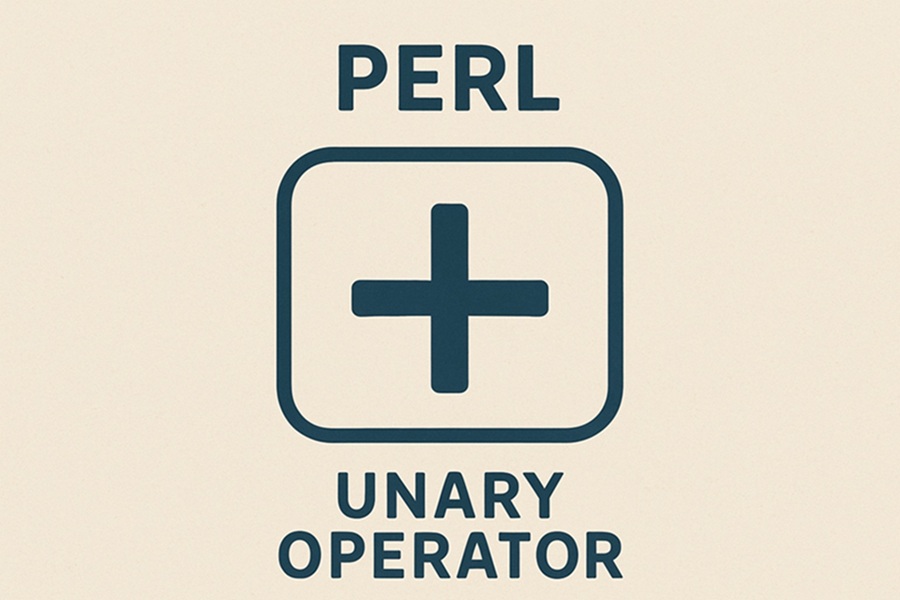DISCLAIMER: Image is generated using ChatGPT.
The unary + operator in Perl has a very specific and important purpose but it’s quite different from it’s behavior in languages like JavaScript.
In Perl, it’s not a numeric conversion operator.
It’s primary technical aspect is context disambiguation.
Enforcing Scalar Context
Perl has a fundamental concept of context: scalar context and list context.
The result of an operation can change dramatically depending on the context it’s evaluated in.
The unary + operator is used to force an expression to be interpreted in scalar context.
This is most commonly needed when you have a function or an operator that expects a scalar argument but the argument you’re providing is ambiguous and could be interpreted as a list.
The unary + resolves the ambiguity by signaling that what follows is an expression, not a hash reference.
use Data::Dumper;
sub bad {
my %hash;
$hash{ shift } = 'value'; # Ambiguous
return \%hash;
}
sub good {
my %hash;
$hash{ +shift } = 'value'; # Unambiguous
return \%hash;
}
print Dumper(bad('key')); # { 'shift' => 'value' };
print Dumper(good('key')); # { 'key' => 'value' };
What unary + operator is NOT in Perl?
It’s critical to understand that Perl's unary + operator does not convert data types.
a) It does not convert a string to a number.
b) It does not have any mathematical effect on numbers.
my $string = "123abc";
my $number = +$string; # This does NOT convert the string to 123!
print $number; # Still prints "123abc"
my $num = 5;
my $result = +$num; # $result is just 5. The + is a no-op here.
If you need to convert a string to a number, you would typically just use the string in a numeric context (like a mathematical operation) and Perl will do the conversion for you.
my $string = "123abc";
my $number = 0 + $string; # Numeric context
print $number; # Now prints "123"
Ambiguous blocks with map
The map function takes either a block {...} or an expression.
The parser has to figure out which one you’re using.
map { $_ * 2 } @array; # the braces are a block for map
This is also clear - no braces, just an expression.
map $_ * 2, @array; # no braces, just an expression
The ambiguity arises when you want to use a complex expression that includes a dereference or another block.
More Examples
my @nums = (1, 2, 3);
my @wrong = map ($_ => $_ * 2), @nums; # ('0')
my @right = map +($_ => $_ * 2), @nums; # (1,2,2,4,3,6)
The map ($_ => $_ * 2), @nums is parsed differently than you might expect.
In Perl, map EXPR, LIST expects a single expression.
The parentheses here ( $_ => $_ * 2 ) don’t behave as a list.
Instead, Perl interprets it as the first element of map being a void context, which evaluates to 0.
Whereas in map +($_ => $_ * 2), @nums, the unary + operator forces the parentheses to be treated as a list expression not a block or ambiguous expression.
Now map sees the correct list ($_ => $_ * 2) for each element of @nums.
Here’s one more example:
my @names = ('Joe','Blog');
my @refs_block = map {{ name => $_ }} @names; # ({'name' => 'Joe'}, {'name' => 'Blog'})
my @refs_plus = map +{ name => $_ }, @names; # ({'name' => 'Joe'}, {'name' => 'Blog'})
The unary + operator applies to what follows immediately, it’s saying "treat the next token as the start of an expression"
It’s purely syntactic at runtime, the unary + operator has no effect on the value.
my $href = +{ key => 'value' }; # Same as { key => 'value' }
This pattern appears with other functions that take blocks or expressions, like grep.
grep +{ $_->{active} }->{value}, @users;
If your expression doesn’t contain ambiguous braces then you don’t need the unary + operator.
These are fine without unary + operator.
map $_->{name}, @array_of_hashrefs; # No braces at all
map $some_hash{$_}, @keys; # No ambiguous braces
map [ $_->{x}, $_->{y} ], @points; # Square brackets are unambiguous
With map, unary + operator serves as a syntactic disambiguator that tells Perl to interpret {...} as a hash reference constructor (an expression) rather than as a map block.
It’s a crucial tool for writing correct Perl code when you need to return hash references or other brace-delimited constructs from map.
Happy Hacking !!!
